PIONEER includes de-identified/pseudonymised data from patients who were seen by an acute care provider from 1st January 2000 and will include data from patients until the project closes (2025 at the earliest). Each dataset will be bespoke, creating to match the specific project.
Some of our datasets are listed below, but each can be finessed or expanded to meet your direct requirements, and many other conditions, pathways or therapy areas are available. If you don’t see what you need, please contact a member of the PIONEER team.
Specialist datasets available
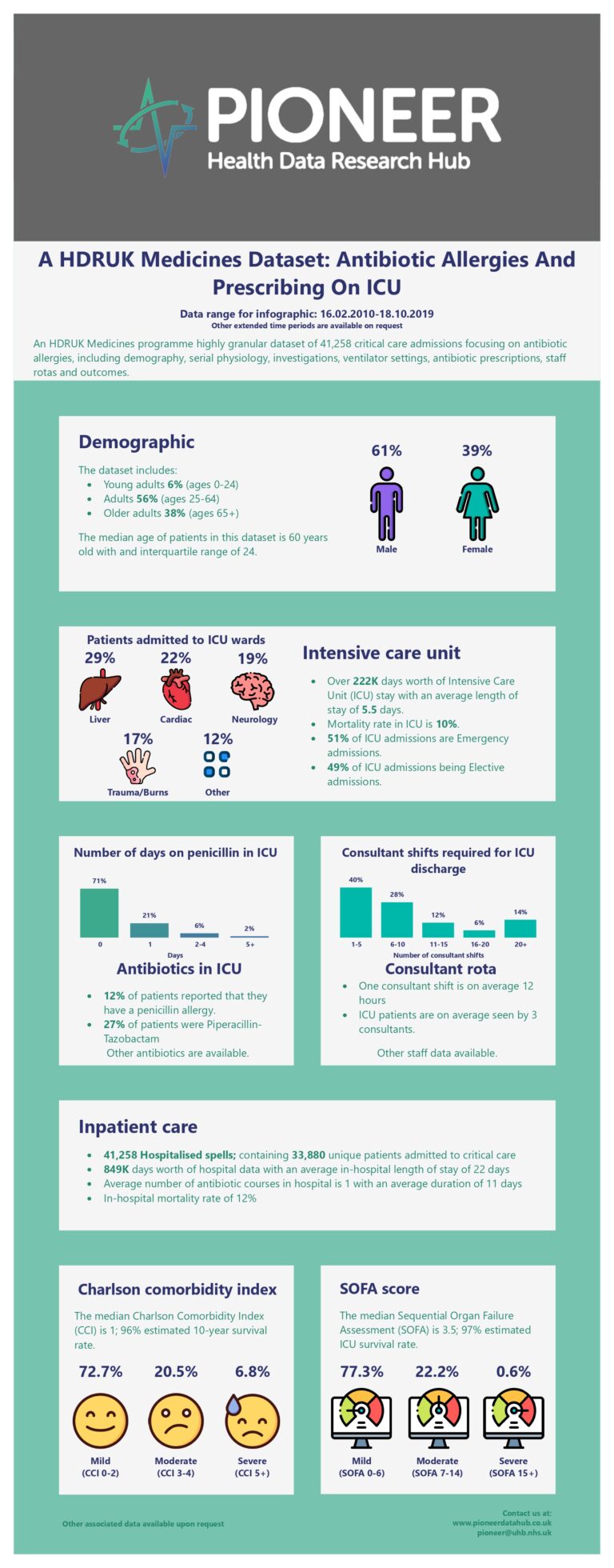
A HDRUK Medicines Dataset: Antibiotic Allergies and Prescribing on ICU
An HDRUK Medicines programme highly granular dataset of 41,258 critical care admissions focusing on antibiotic allergies, including demography, serial physiology, investigations, ventilator settings, antibiotic prescriptions, staff rotas and outcomes.
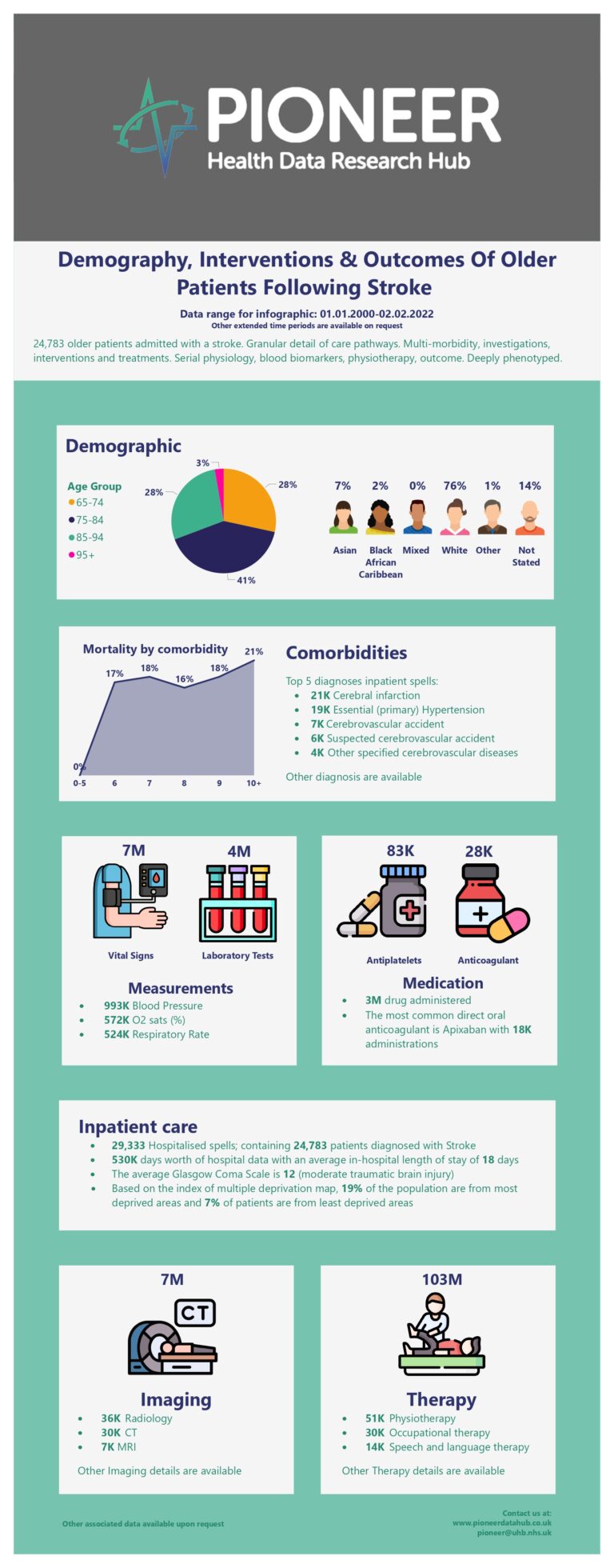
Demography, Interventions & Outcomes of Older Patients Following Stroke
24,783 older patients admitted with a stroke. Granular detail of care pathways. Multi-morbidity, investigations, interventions and treatments. Serial physiology, blood biomarkers, physiotherapy, outcome. Deeply phenotyped.
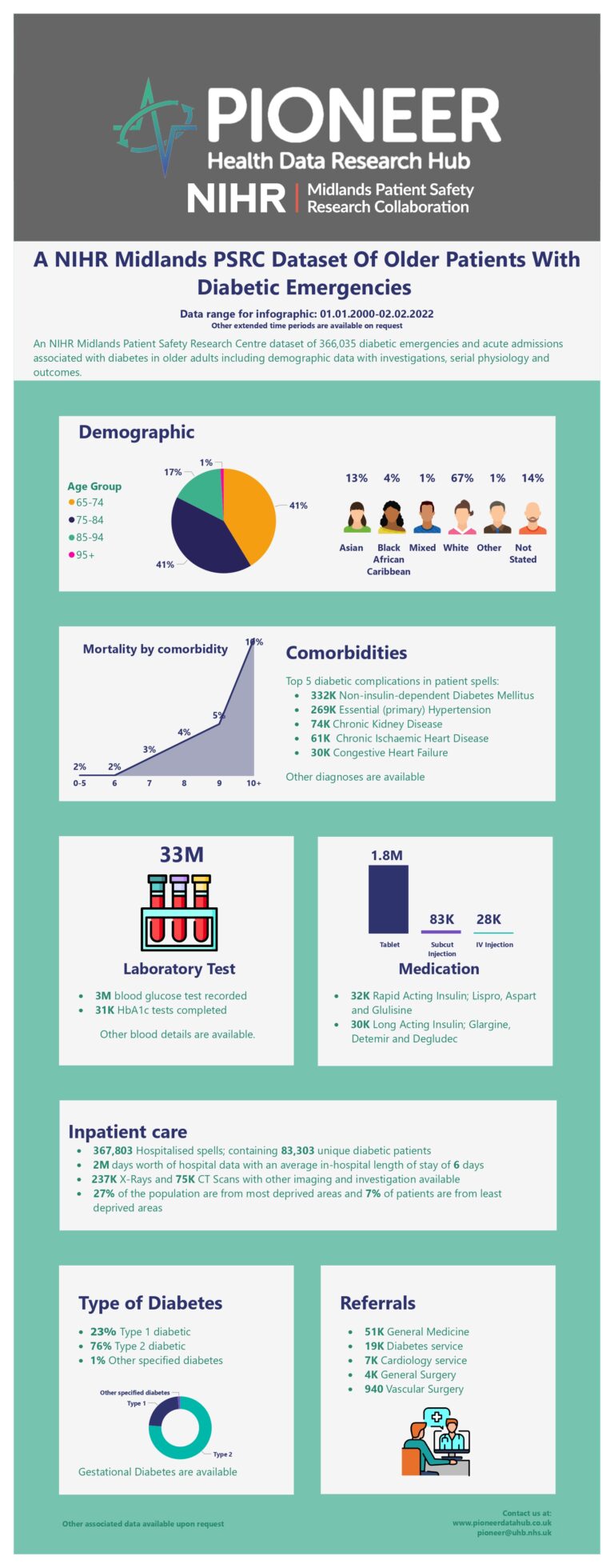
A NIHR Midlands PSRC dataset of Older Patients with Diabetic Emergencies
An NIHR Midlands Patient Safety Research Centre dataset of 366,035 diabetic emergencies and acute admissions associated with diabetes in older adults including demographic data with investigations, serial physiology and outcomes.

NIHR Midlands PSRC Dataset: Guideline Adherence in Community Acquired Pneumonia
A highly granular dataset of 31,417 patients with Community Acquired Pneumonia curated by PIONEER for NIHR Midlands Patient Safety Research Collaboration with demographics, comorbidities, serial vital signs, imaging and labs; medications, outcomes.

An HDRUK Dataset: Linked Health and Air Quality Data for Older Adults
An HDRUK QQ2 longitudinal dataset of 3,175,299 admissions for patients aged 65+, linking DEFRA air pollution data to acute care presentations. Includes acuity, respiratory data, medications and outcomes to assess environmental health impacts.

NIHR Birmingham BRC Dataset Outcomes for Older Adults on Critical Care
An NIHR Birmingham BRC dataset of 8,656 intensive care admissions for patients aged 65+. Includes severity scores (APACHE, SAPS, SOFA), investigations, serial physiology, treatments, and outcomes up to one-year post-admission.

NT-proBNP in Sepsis Patients Aged 65+: NIHR Birmingham BRC Dataset
A National Institute for Health and Care Research (NIHR) Birmingham Biomedical Research Centre (BRC) dataset featuring serial NT-proBNP measurements for patients aged 65+ with sepsis, ARDS, and polytrauma admitted to intensive care from a diverse cohort.

Acute Care Patients Aged 65+ with Complex Multimorbidity NIHR OPTIMAL Dataset
Longitudinal data for 15,950 patients aged 65+ presenting acutely with multimorbidity. Includes demographics, comorbidities, serial physiology, frailty scores, blood results, medications, allergies, treatments, procedures, and 12-month mortality outcomes.

Developing Tools to Prevent Avoidable Admissions for Patients Aged 65 and Older
A granular dataset of 130,753 Emergency Department presentations for patients aged 65+, curated by PIONEER working with HDR-UK. Includes demographics, serial physiology, acuity, investigations, treatments, and outcomes to study avoidable admissions.

Improving Care for Suspected Myocardial Infarction in Patients Aged 65 and Over
A granular dataset of >16k presentations for suspected myocardial infarction in patients aged 65+. Includes demographics, comorbidities, symptoms, ECGs, lab results (troponins), imaging, procedures, medications, mortality and readmissions.

Synthetic Dataset of Hospitalised Patients with an Acute Exacerbation of Asthma
A synthetic dataset of hospital admissions for 561 patients admitted with an acute exacerbation of asthma, including their demographics and clinical records collected during hospital admissions.

An NIHR Birmingham BRC Dataset of Community-Acquired Pneumonia in Older Adults
A NIHR Birmingham BRC dataset of 1,701 community-acquired pneumonia spells for adults aged 65+, curated by PIONEER. Includes demography, comorbidities, frailty, symptoms, physiology, acuity, investigations, treatments (drug, dose, route), and outcomes.
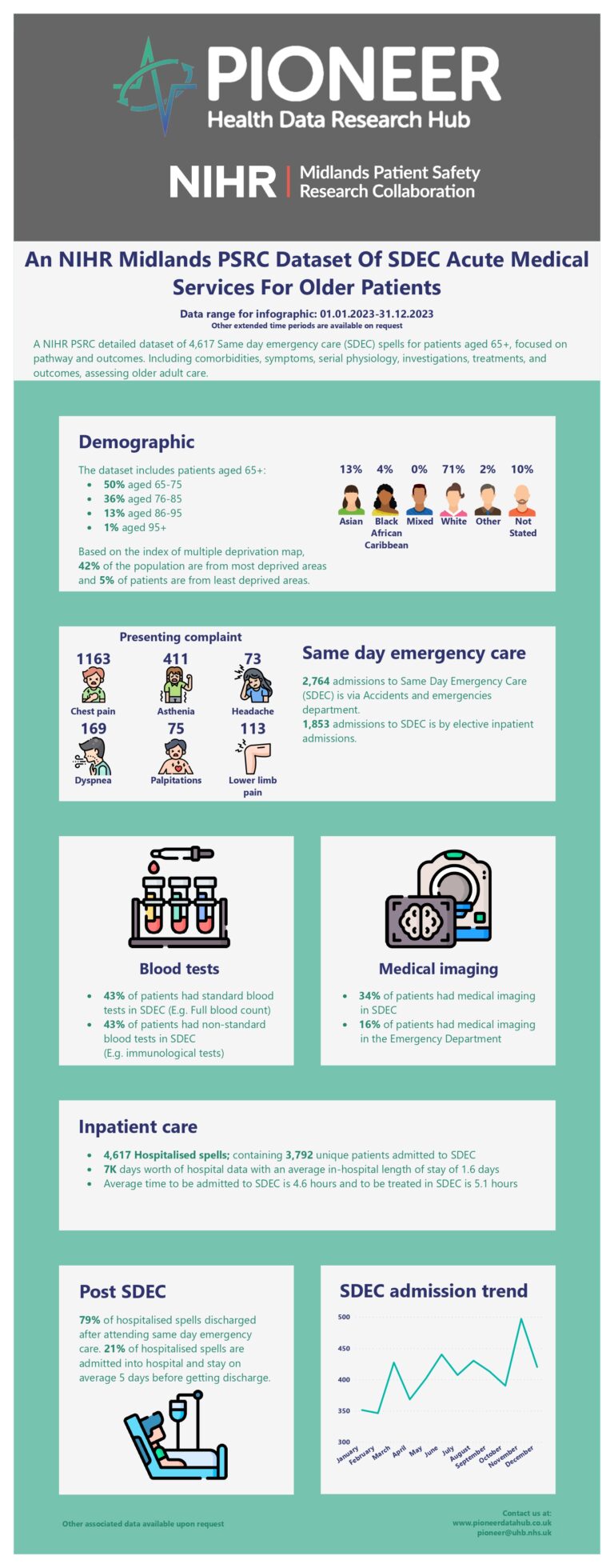
An NIHR Midlands PSRC Dataset of SDEC Acute Medical Services for Older Patients
A NIHR PSRC detailed dataset of 4,617 Same Day Emergency Care (SDEC) spells for patients aged 65+, focused on pathway and outcomes. Includes comorbidities, symptoms, serial physiology, investigations, treatments, and outcomes, assessing older adult care.

Surgical Virtual Ward Outcomes for Patients Aged 65 and Older in New Care Models
A detailed dataset of 451,306 surgical admissions for patients aged 65 and older, including those admitted to a Virtual Surgical Ward. Curated by PIONEER, it covers demography, comorbidities, serial physiology, investigations, treatments, and outcomes

Influenza Hospitalisation Outcomes in Smokers vs Non-Smokers Aged 65 and Older
A dataset of 13,524 influenza admissions for adults aged 65 and over from Jan 2018 to Jul 2024. Includes demography, serial physiology, assessments, diagnostic codes, initial presentation, ventilation, ICU transfers, prescriptions, and outcomes.
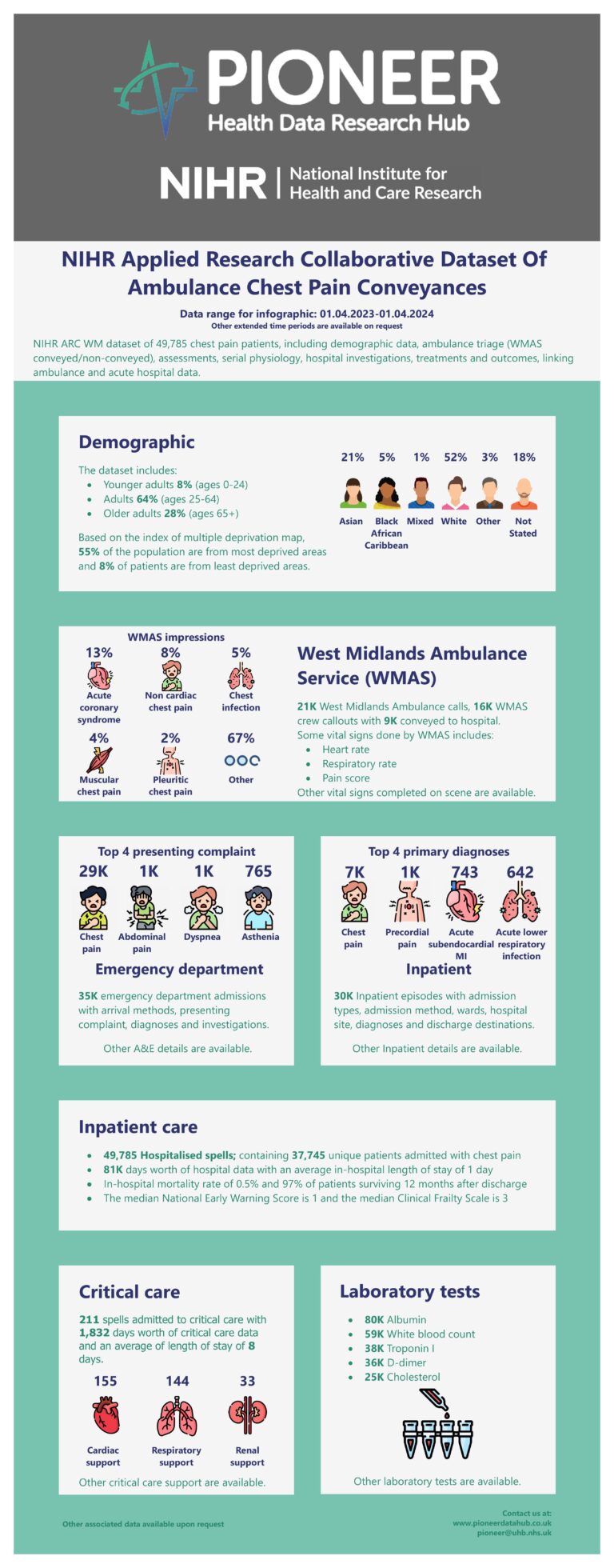
NIHR Applied Research Collaborative Dataset of Ambulance Chest Pain Conveyances
NIHR ARC WM dataset of 49,785 chest pain patients, including demographics, ambulance triage (WMAS conveyed/non-conveyed), assessments, serial physiology, hospital investigations, treatments and outcomes, linking ambulance and acute hospital data.
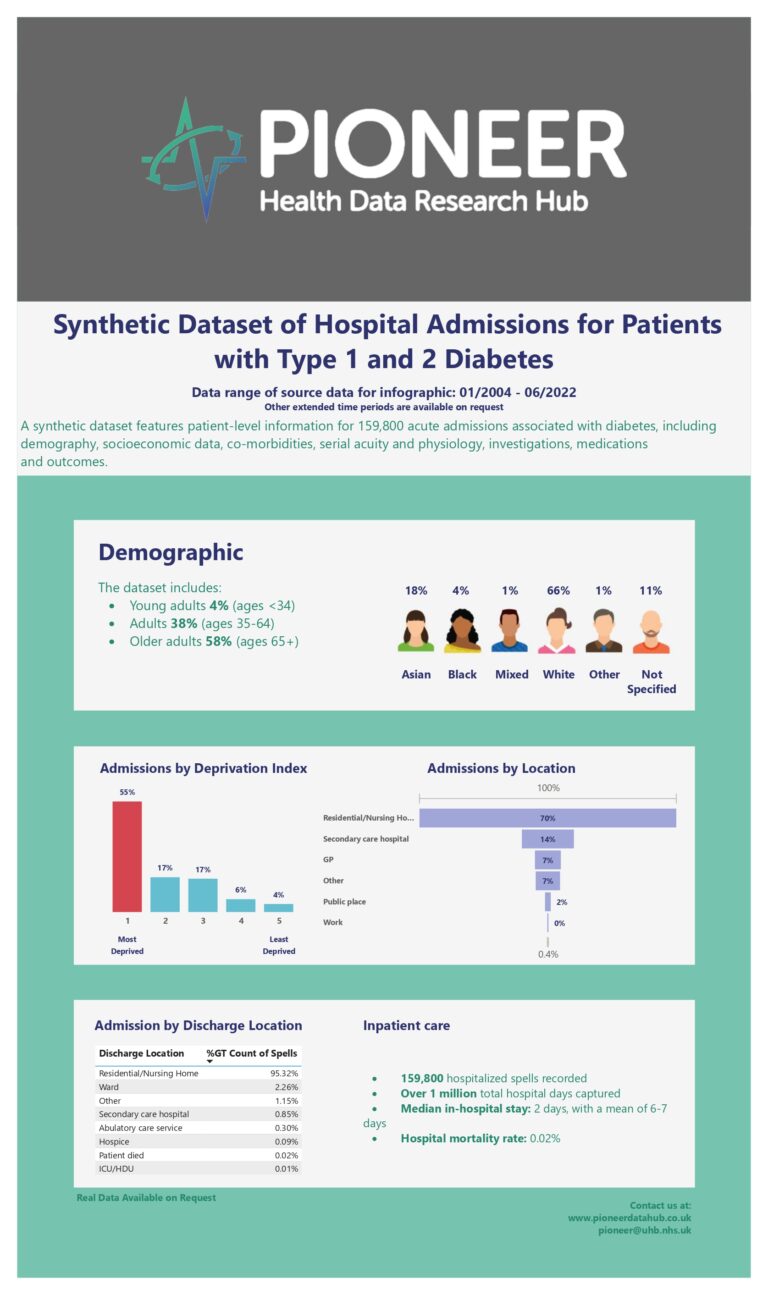
Synthetic Dataset of Hospital Admissions for Patients with Type 1 and 2 Diabetes
A synthetic dataset features patient-level information for 159,800 acute admissions associated with diabetes, including demography, socioeconomic data, co-morbidities, serial acuity and physiology, investigations, medications and outcomes.

Synthetic Data Acute Atrial Fibrillation Patient Profiles, Clinical Insights
A synthetic dataset featuring patient-level information for >24,000 acute admissions with atrial fibrillation, including demographics, co-morbidities, symptoms, investigations, medications and outcomes, derived from real patient records.

Synthetic Dataset of Acute Admissions for Patients of Intentional Drug Overdose
A synthetic dataset for 16,276 acute admission patients treated with intentional drug overdose, including demographics, primary diagnosis, referral, medication, follow-ups and other clinical records during hospital admissions.

NHS Priority Challenge: Developing Tools to Prevent Avoidable Admissions
A highly granular dataset of 503,154 Emergency Department presentations curated by PIONEER, working with HDR-UK. The data includes admission details, demography, presenting symptoms, serial physiology and acuity, investigations, treatments, and outcomes.

Synthetic Dataset of Hospital Admissions for an Acute Stroke
A synthetic dataset features patient-level information for 29K acute admissions associated with stroke, including demographics, socioeconomic status, presenting symptoms, time from onset, serial physiology, investigations, treatments and outcomes.

Outcomes of Influenza Related Hospitalisations in Smokers vs. Non-smokers
A dataset of 26,047 admissions with influenza from Jan 2018 to Jul 2024. Data includes demography, serial physiology, assessments, diagnostic codes (ICD-10 & SNOMED-CT), initial presentation, ventilation, ICU transfers, prescriptions and outcomes.

NIHR Dataset Penicillin Allergy and the Presence of Antimicrobial Resistance
A NIHR supported, highly granular dataset of 17k acute bloodstream infection spells curated by PIONEER, including demography, stated allergies, symptoms, physiology, investigations including microbiology, diagnoses, medications and outcomes.

A NIHR Birmingham BRC Dataset: Macrolide Use in Patients with Viral Pneumonia
A NIHR Birmingham BRC, granular dataset of 2,692 viral pneumonia admissions, curated with respiratory clinicians and PIONEER, including demography, symptoms, physiology, investigations, treatments (drug, dose, route), outcomes, and severity scores.

Socioeconomic and Environmental Factors and Outcomes of Acutely Unwell Patients
A highly granular dataset of 8,803 spells admitted to Intensive care unit curated by PIONEER, including demography, comorbidity and physiology/acuity, all investigations and treatments, deprivation indices, geolocation and weather data.

NHS Priority Challenge for New Models of Care: A Surgical Virtual Ward
A highly granular dataset of 1,655,756 surgical admissions who were/were not admitted to a Virtual Surgical Ward, curated by PIONEER, including demography, comorbidities, presenting symptoms, serial physiology, investigations, treatments and outcomes.

HDRUK Medicine Dataset: Digoxin Repurposing as a Senolytic in Pneumonia
A highly granular dataset of 63k Community Acquired Pneumonia spells curated by PIONEER and the HDRUK Medicines Programme to investigate digoxin as a senolytic, including demography, symptoms, serial physiology, investigations, medications and outcomes.

Identifying and Addressing Avoidable Readmissions Following Hip Fracture
Highly granular dataset of >5800 patients with a hip fracture including demographics, vital signs, acuity scores, clinical assessments, investigations, laboratory and imaging results, medications, surgeries, outcomes, and readmissions.
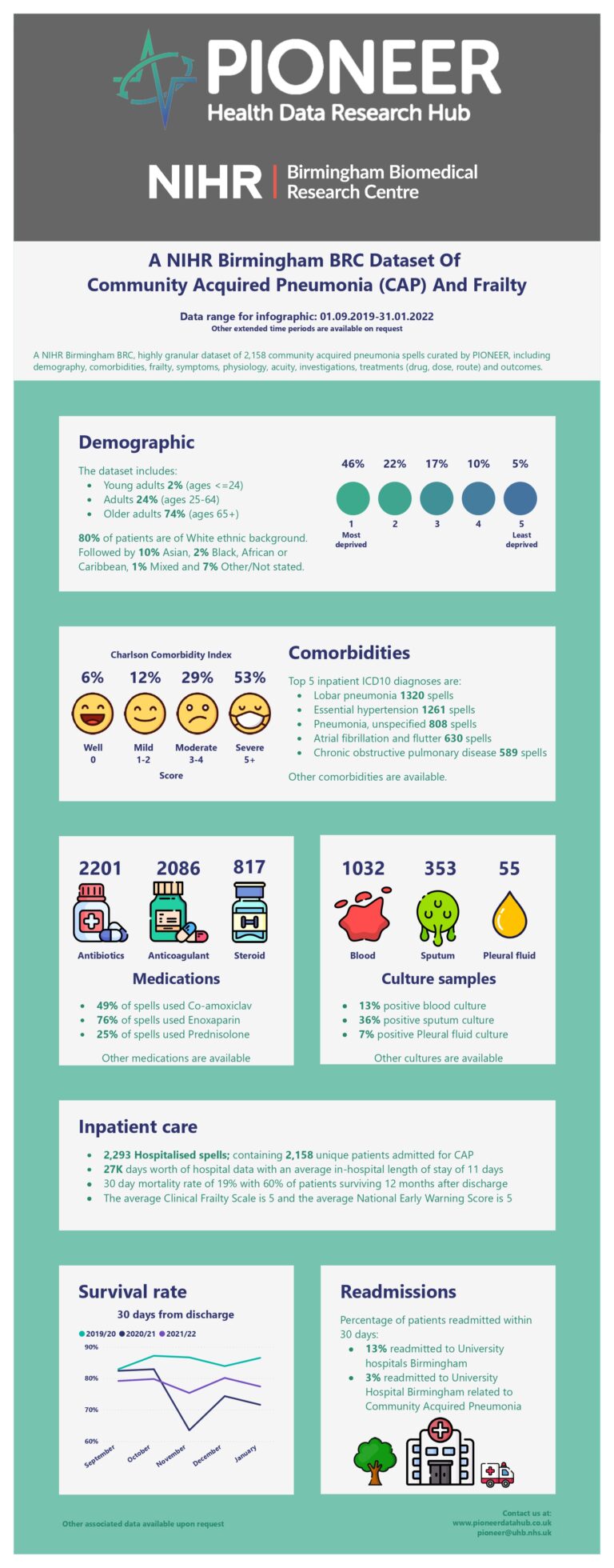
A NIHR Birmingham BRC Dataset of Community Acquired Pneumonia (CAP) and Frailty
A NIHR Birmingham BRC, highly granular dataset of 2,158 community acquired pneumonia spells curated by PIONEER, including demography, comorbidities, frailty, symptoms, physiology, acuity, investigations, treatments (drug, dose, route) and outcomes.

Virtual wards for Exacerbations of Chronic Obstructive Pulmonary Disease
A granular dataset of 7k patients on a Respiratory Virtual Ward for exacerbations of Chronic Obstructive Pulmonary Disease, including demography, serial physiology, DECAF scores, diagnostic codes, presenting symptoms, Imaging, Prescriptions, and outcomes.

ADMISSIONS Programme Data: Multiple Long-term Conditions in Hospital Patients
An Admission programme dataset of 119,815 hospitalised patients including demography, presenting symptoms, diagnoses, imaging, investigations, medications, procedures, operations and outcomes, with a focus on multiple long-term conditions.

NIHR Patient Safety Research Collaboration Medicines & Kidney Injury Dataset
NIHR Midlands Patient Safety Research Collaboration dataset containing 449,472 hospitalised patients, including demographics, comorbidities, renal function, serial physiology and laboratory results, medications with dose and route of administration.

NHS Priority Challenge: Improving Medical Care in Unplanned, Emergency Services
A highly granular dataset of 35k acutely unwell patients referred to medicine from Emergency Departments, including demography, serial physiology and acuity, presenting symptoms, investigations and results, Ward locations and outcomes.

A NIHR Birmingham BRC Dataset: Hospital Acquired Pneumonia and Antimicrobial Use
A NIHR Birmingham BRC, highly granular dataset of 22.5k hospital acquired pneumonia spells curated by PIONEER, including demography, presenting symptoms, serial physiology, investigations, Charlson comorbidity index, medications, and outcomes.

Investigation Pathways for Patients Presenting to Hospitals with Headaches
A highly granular dataset of 33,276 patients presenting with headaches to unplanned and emergency care. The data includes demographics, vital signs, acuity, comorbidities, laboratory sample results, investigations and outcomes.

DECOVID: Data Derived from UCLH and UHB during the COVID Pandemic
The DECOVID dataset of 165,414 patients admitted to two large NHS Trusts with suspected COVID-19, including demographics, serial physiology measurements, laboratory tests, co-morbidities, presenting symptoms, ITU admissions and outcomes.

HDRUK Medicines: Self-Reported Penicillin Allergy and Outcomes on Intensive Care
A highly granular dataset of 37,639 critical care admissions with and without self-reported penicillin allergies. The data includes demography, serial physiology, investigations, ventilator parameters, antibiotic prescriptions and outcomes.

A HDRUK Medicines Driver Programme Dataset: Medications on Intensive Care
Highly granular dataset of 9,100 intensive care spells, including demography, serial physiology, consult specialties, diagnostic codes, initial presentation, presenting symptoms, cognition scores and all medications (dose and route).

An NIHR BRC Dataset: Antimicrobial Stewardship and Antimicrobial Resistance
A highly granular dataset of 273,437 admissions curated by PIONEER for the Birmingham BRC, including demography, serial physiology, laboratory tests, diagnoses (ICD10, SNOMED CT), procedures (OPCS4), prescriptions, microbiology results and outcomes.
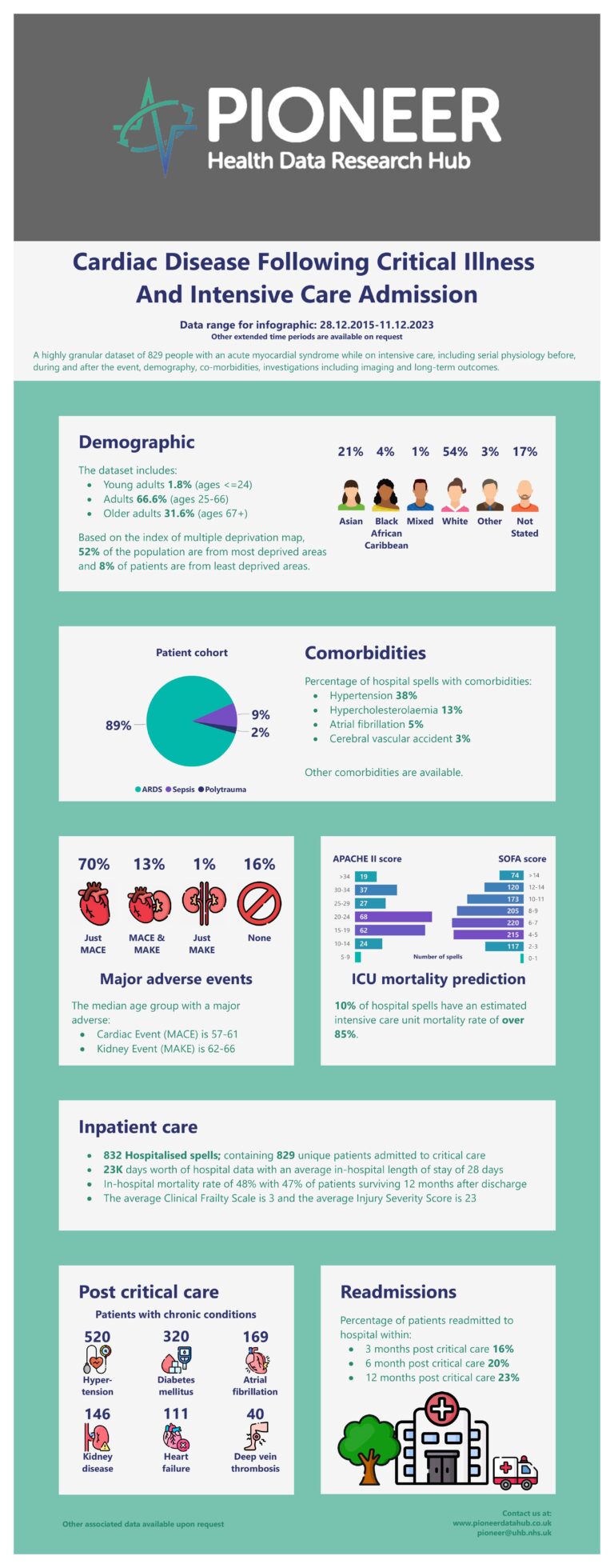
Cardiac Disease Following Critical Illness and Intensive Care Admission
A highly granular dataset of 829 people with an acute myocardial syndrome while on intensive care, including serial physiology before, during and after the event, demography, co-morbidities, investigations including imaging and long-term outcomes.
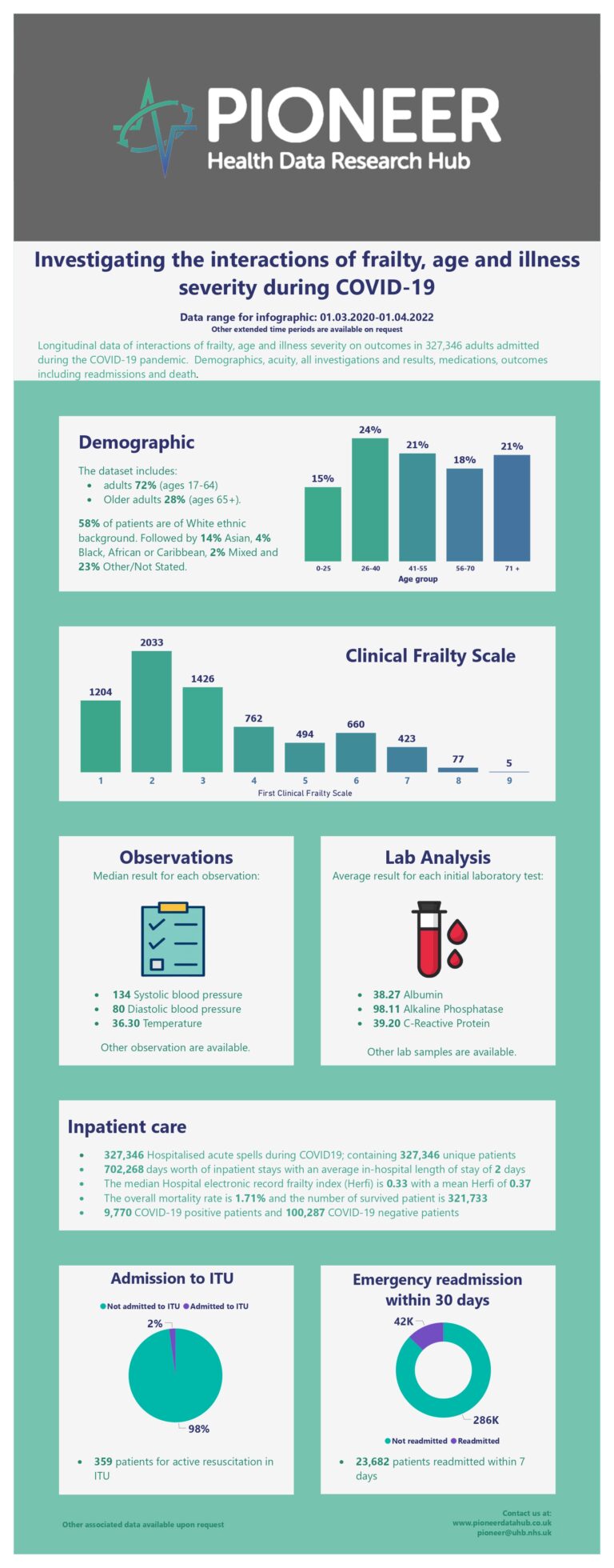
The Interactions of Frailty, Age and Illness Severity during COVID-19
Longitudinal data of interactions of frailty, age and illness severity on outcomes in 327,346 adults admitted during the COVID-19 pandemic. Demographics, acuity, all investigations and results, medications, outcomes including readmissions and death.
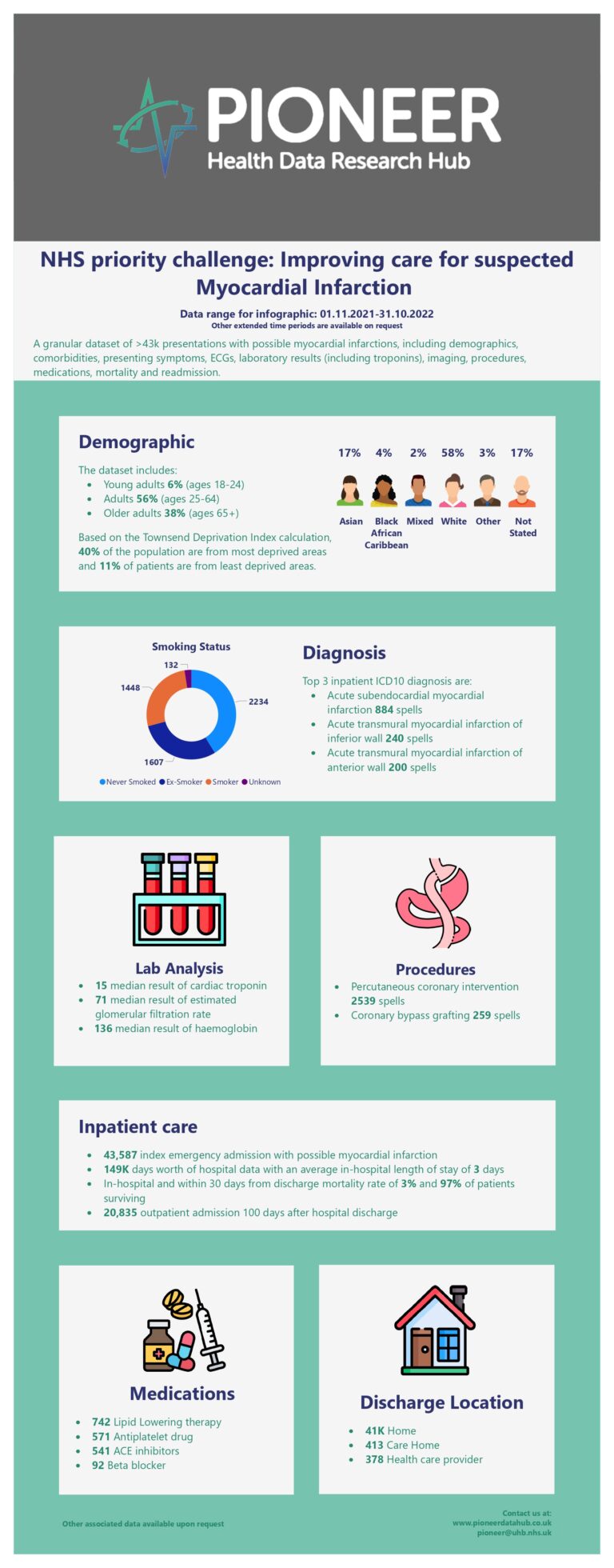
NHS Priority Challenge: Improving Care for Suspected Myocardial Infarction
A granular dataset of >43k presentations with possible myocardial infarctions, including demographics, comorbidities, presenting symptoms, ECGs, laboratory results (including troponins), imaging, procedures, medications, mortality and readmission.

NHS Priority Challenge: Identifying Patients for Same Day Emergency Care
A granular dataset of >300k emergency department presentations including demography, presenting symptoms, serial physiology, acuity, laboratory tests, Glasgow admission prediction score and Ambulatory care score (AMBs), medications, and outcomes.
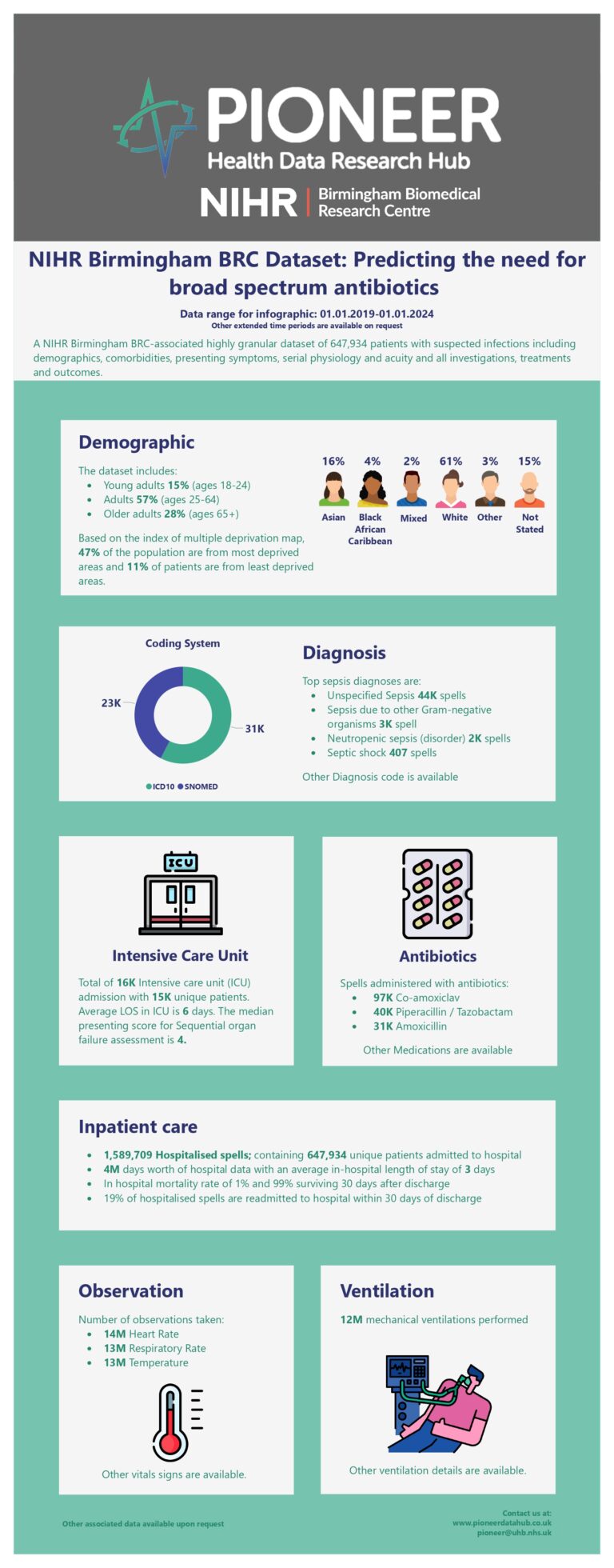
NIHR Birmingham BRC Dataset: Predicting the Need for Broad Spectrum Antibiotics
A NIHR Birmingham BRC-associated highly granular dataset of 647,934 patients with suspected infections including demographics, comorbidities, presenting symptoms, serial physiology and acuity and all investigations, treatments and outcomes.

NIHR Midlands ARC Dataset: Outcomes from Out-of-Hospital Cardiac Arrest
A highly granular dataset of 1588 Cardiac arrests curated by PIONEER in collaboration with West Midlands Ambulance Service (WMAS), including demography, initial presentation, serial physiology, investigations, treatment and outcomes.
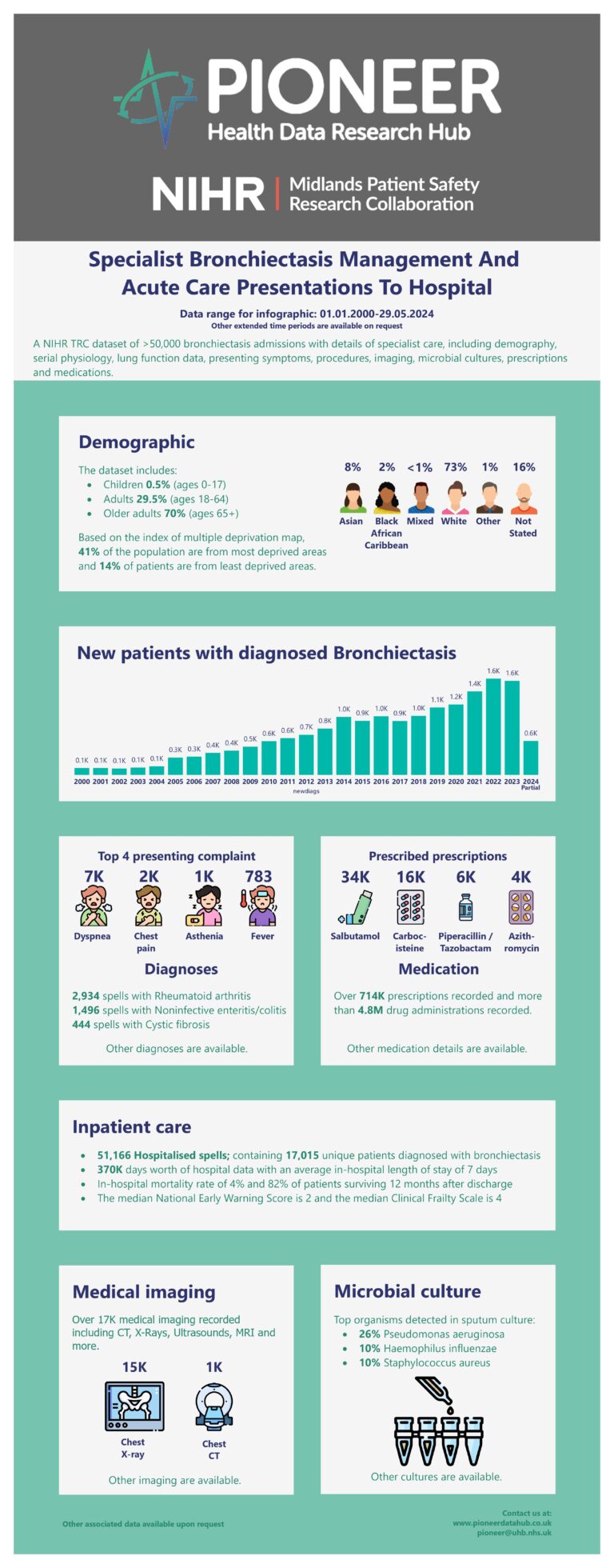
Specialist Bronchiectasis Management and Acute Care Presentations to Hospital
An NIHR TRC dataset of >50,000 bronchiectasis admissions with details of specialist care, including demography, serial physiology, lung function data, presenting symptoms, procedures, imaging, microbial cultures, prescriptions and medications.
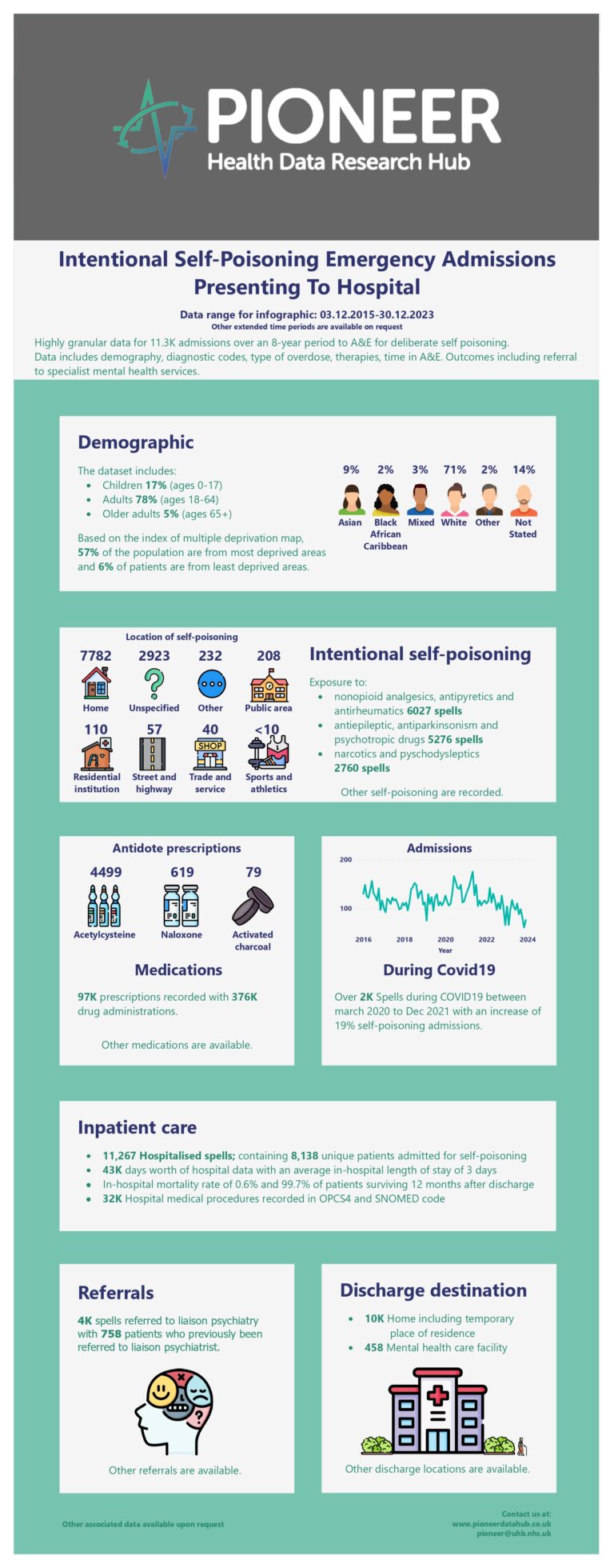
Synthetic Dataset of Hospital Admissions for Cancer Patients with ICI Treatment
A synthetic dataset features patient-level information for 683 cancer patients treated with checkpoint inhibitors, including demographics, primary cancer diagnoses, details of ICI treatments, and other clinical records during hospital admissions.

Intentional Self-Poisoning Emergency Admissions Presenting to Hospital
Highly granular data for 11.3k admissions over an 8-year period to A&E for deliberate self-poisoning. Data includes demography, diagnostic codes, type of overdose, therapies, time in A&E. Outcomes including referral to specialist mental health services.
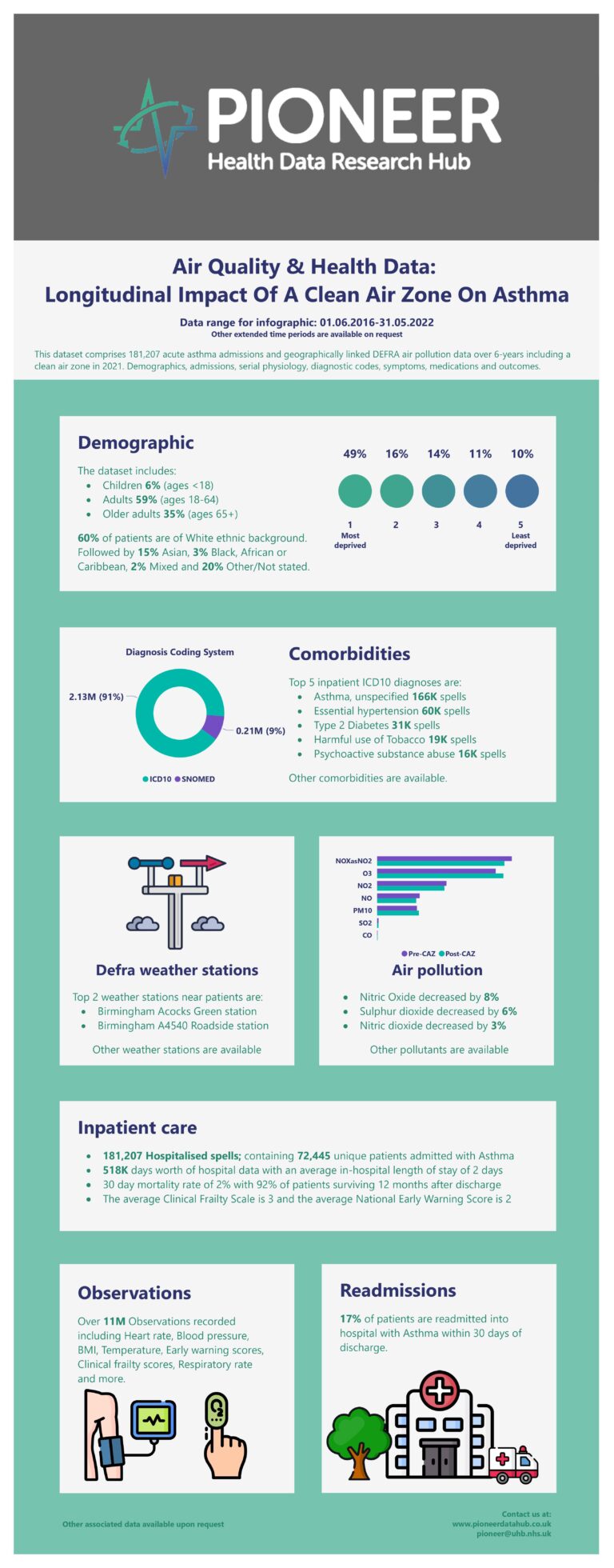
Air Quality & Health Data: Longitudinal Impact of a Clean Air Zone on Asthma
This dataset comprises 181,207 acute asthma admissions and geographically linked DEFRA air pollution data over 6-years including a clean air zone in 2021. Demographics, admissions, serial physiology, diagnostic codes, symptoms, medications and outcomes.
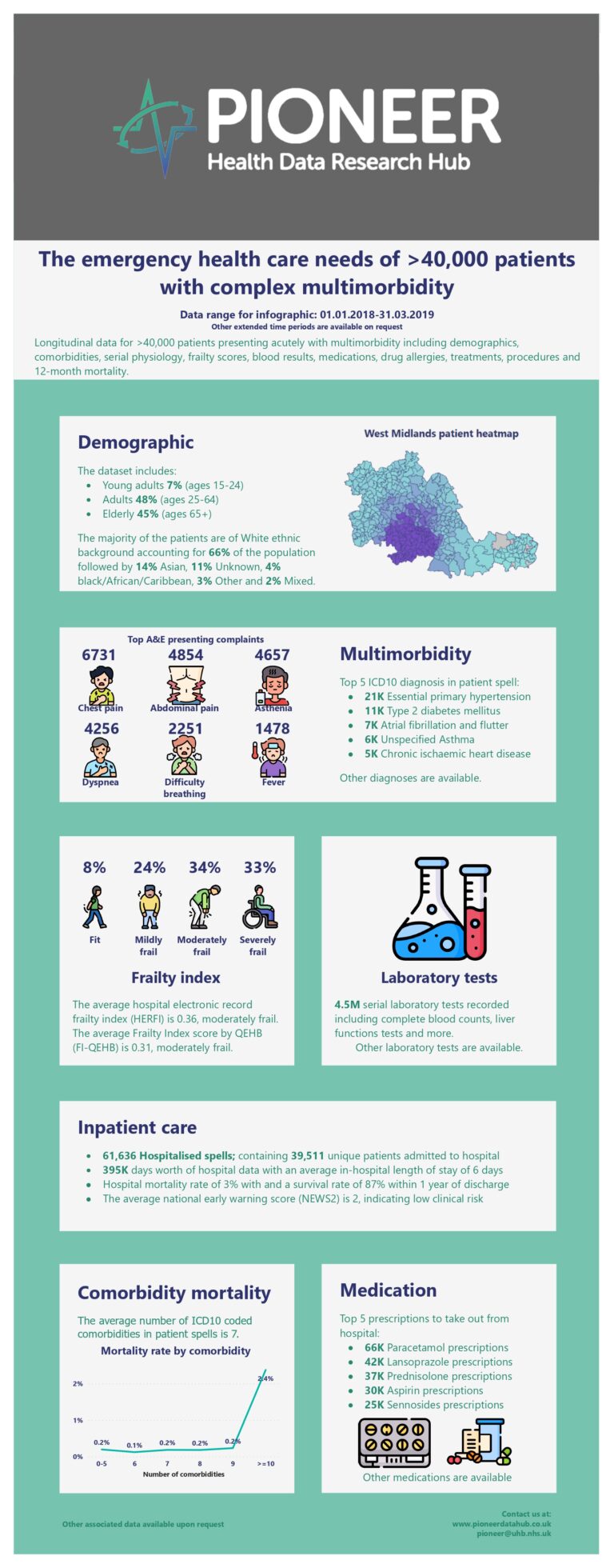
The Emergency Health Care Needs of >40,000 Patients with Complex Multimorbidity
Longitudinal data for >40,000 patients presenting acutely with multimorbidity including demographics, comorbidities, serial physiology, frailty scores, blood results, medications, drug allergies, treatments, procedures and 12-month mortality.
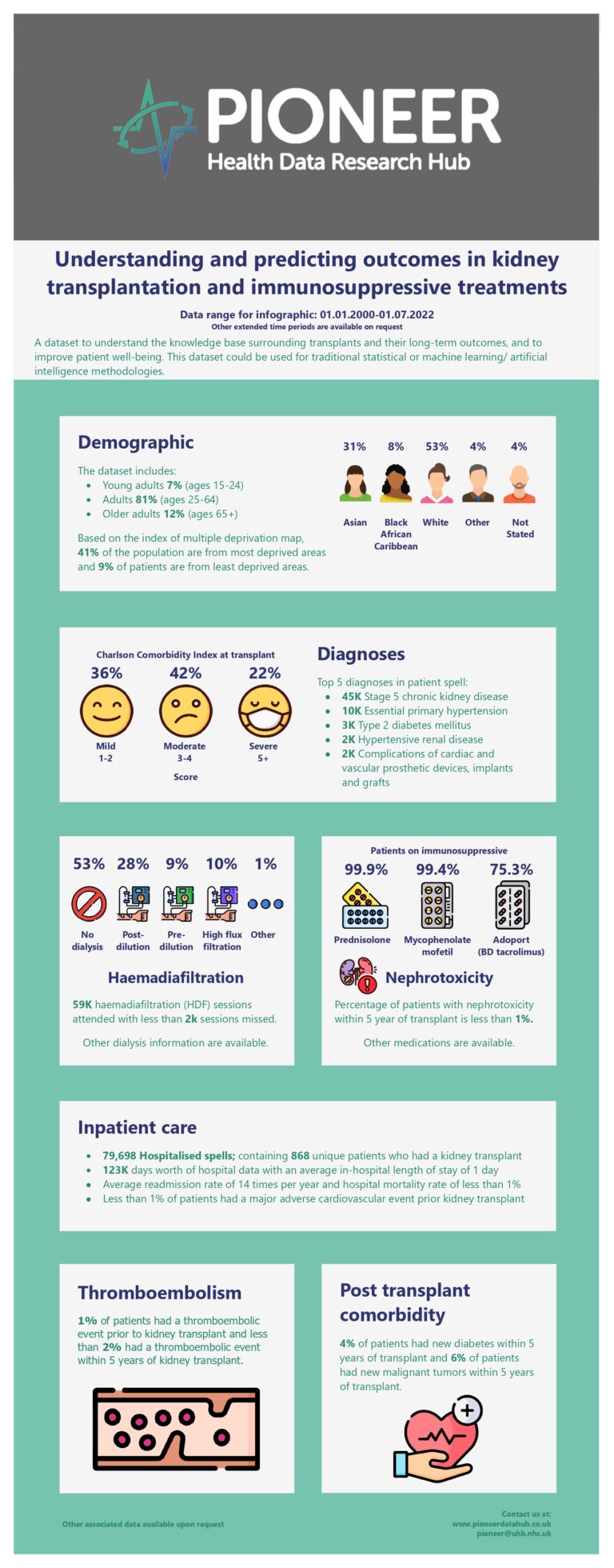
Transplants in Renal Disease: Outcomes and the Effects of Immunosuppression
Detailed dataset of >860 patients following a renal transplant on immunosuppressive treatments curated by PIONEER (Jan 2000 to Jul 2024). Granular pathways. Deeply phenotyped. Serial physiology, blood markers, demography, outpatient data and outcomes.

Synthetic Dataset – Patients at Risk of Sudden Death: Hypertrophic Cardiomyopathy
Synthetic data replicating 20,000 ethnically diverse hypertrophic cardiomyopathy patients: This includes clinical and biological phenotyping, co-morbidities, investigations (including ECG, ECHO), any procedures undertaken and outcomes.

Admission Patterns in Multiple Long-Term Conditions: NIHR/UKRI ADMISSION Dataset
Longitudinal data (>10-years) for >70,000 patients, including accrual of comorbidities, acute admissions and outcomes, detailed demographics, ICD-10 codes, and time-stamped acute care data including acuity, physiology, investigations, and medicines.

Clinical Characteristics of Hospitalised Primary Biliary Cholangitis Patients
Detailed dataset of >3.5k patients with hospitalised Primary Biliary Cholangitis (March 2000 to January 2024). Granular care pathways. Deeply phenotyped. Serial physiology, blood markers. Demography, investigations, treatments and outcomes.
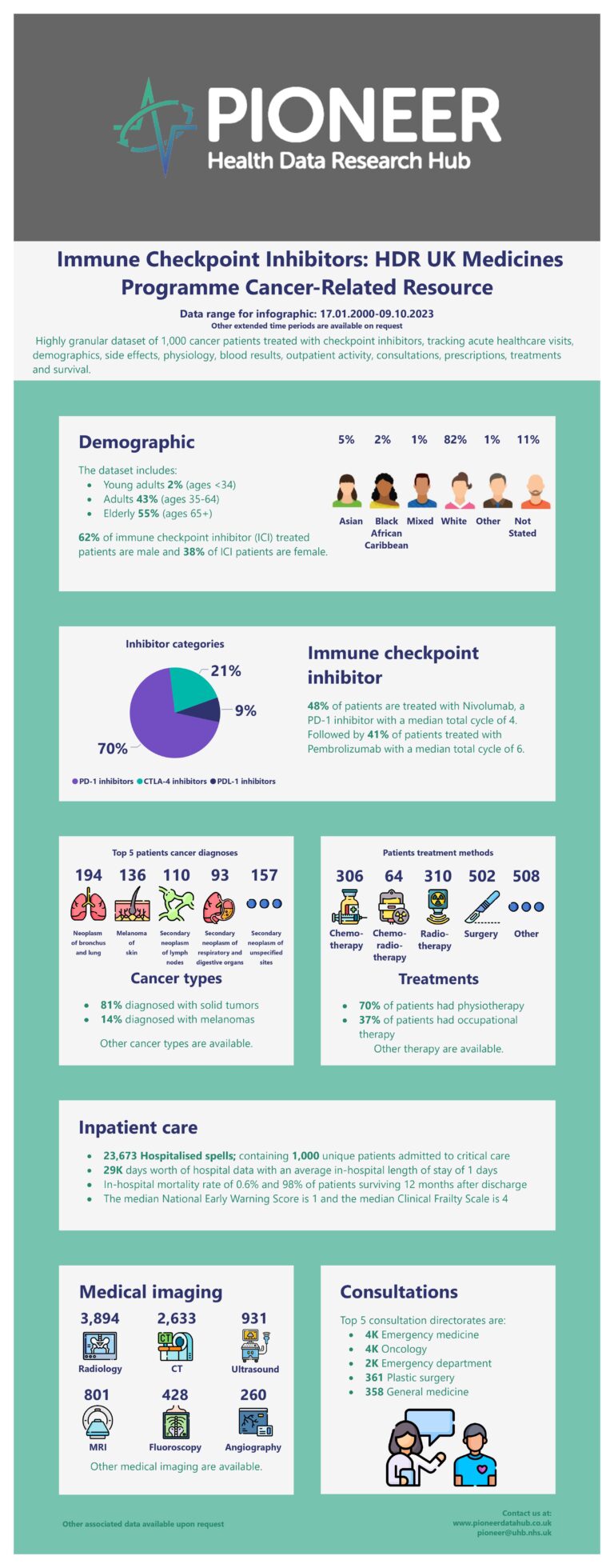
Immune Checkpoint Inhibitors: HDR UK Medicines Programme Cancer-Related Resource
Highly granular dataset of 1,000 cancer patients treated with checkpoint inhibitors, tracking acute healthcare visits, demographics, side effects, physiology, blood results, outpatient activity, consultations, prescriptions, treatments, and survival.

Environmental Determinants of Health: Linked Health and DEFRA Air Quality Data
An HDRUK QQ2 highly granular longitudinal dataset of 10,908,440 admissions matching DEFRA air pollution data to acute care presentations, including demographic data, acuity, presenting complaint and symptoms, respiratory data, medications and outcomes.
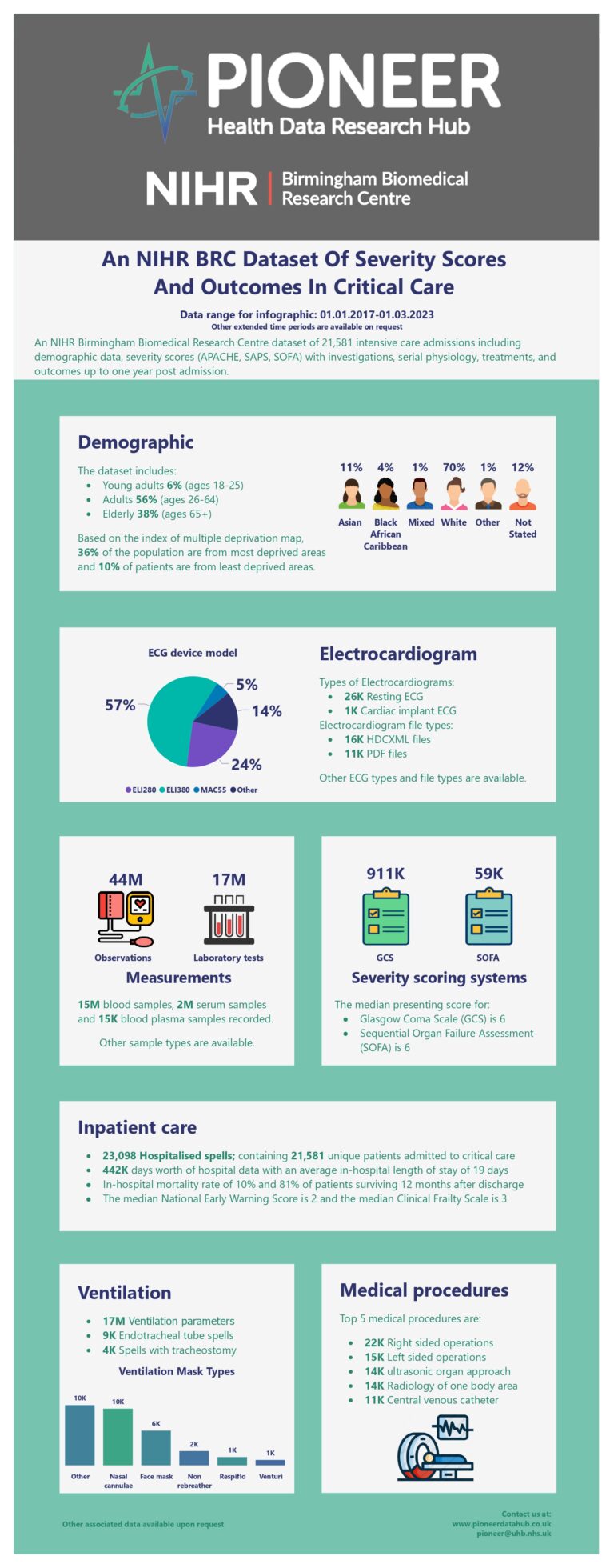
An NIHR Birmingham BRC Dataset of Severity Scores and Outcomes in Critical Care
An NIHR Birmingham Biomedical Research Centre dataset of 21,581 intensive care admissions including demographic data, severity scores (APACHE, SAPS, SOFA) with investigations, serial physiology, treatments, and outcomes up to one year post admission.

Hospitalised Patients with Diabetic Emergencies & Acute Diabetic Health Concerns
An NIHR Midlands Patient Safety Research Centre dataset of 168,706 diabetic emergencies and acute admissions associated with diabetes-related health concerns, including demographic data with investigations, serial physiology and outcomes.

NT-proBNP in Critically Ill Patients with Sepsis: a NIHR Birmingham BRC Dataset
A National Institute for Health and Care Research (NIHR) Birmingham Biomedical Research Centre (BRC) dataset featuring serial NT-proBNP measurements from a diverse cohort of Intensive Care patients with sepsis, ARDS, and polytrauma.
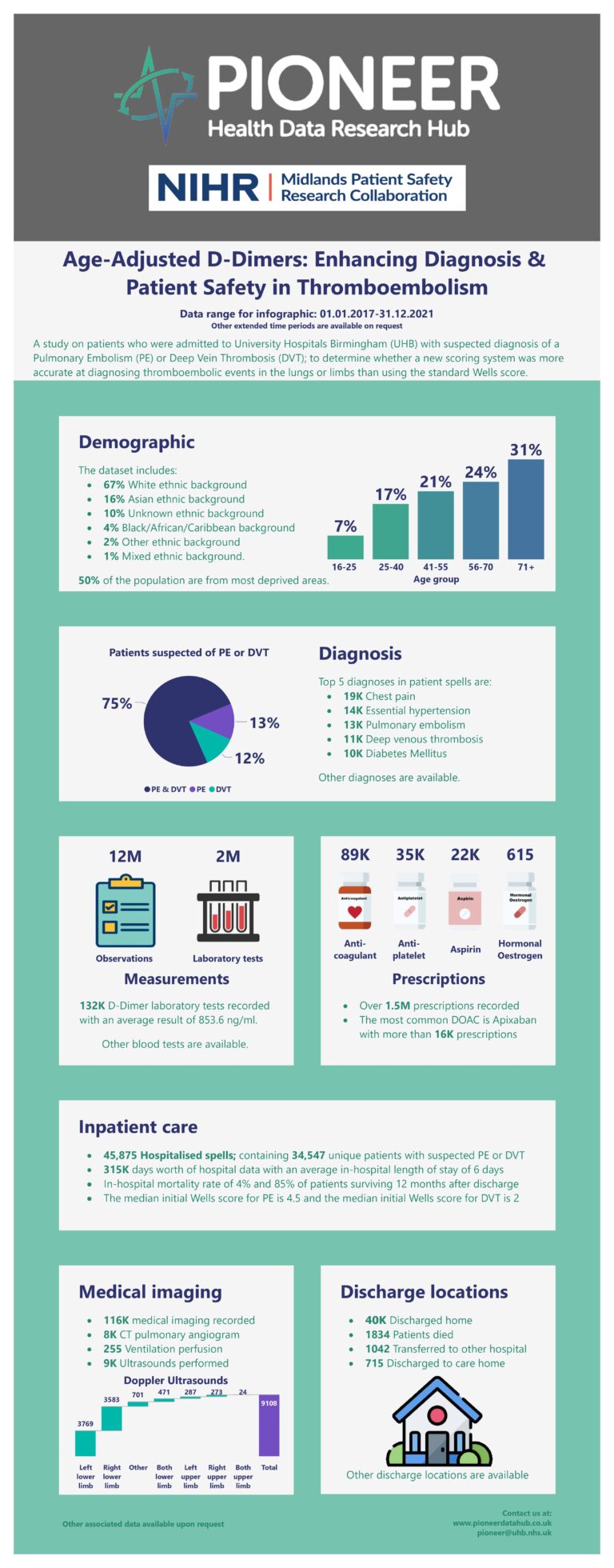
Age-Adjusted D-Dimers: Enhancing Diagnosis & Patient Safety in Thromboembolism
A PIONEER, NIHR Midlands Patient Safety Research Collaborative and NIHR Applied Research Collaboration West Midlands dataset of 27,526 patients with suspected/confirmed thromboembolic events including demographics, physiology, test results and outcomes.

Synthetic Dataset: Hospitalised Patients with Thromboembolic Diagnosis
The incidence of blood clots in the lungs (PE) or limbs (DVT) is estimated to be approximately 50–150 per 100,000 people and in the UK, around 60,000 cases of PE and 200,000 cases of DVT are reported each year. However, despite the significant progress, diagnosing PE and DVT remains a challenge. This large synthetic data with up to 14.5k patients of both suspected and diagnosed thromboembolic events provides key parameters to support critical research into the condition.

Synthetic Dataset: Using Data-driven ML Towards Improving Diagnosis of ACS
Acute compartment syndrome (ACS) is an emergency orthopaedic condition wherein a rapid rise in compartmental pressure compromises blood perfusion to the tissues leading to ischaemia and muscle necrosis. In this dataset, highly granular synthetic data of over 900 patients with ACS is shown to provide the key parameters to support critical research into this condition.

Machine Learning Frailty Index Estimates with Routine Test Results in Acute Care
Frailty is a critical measure in health care for evidence-based clinical decision making. An accurate electronic Frailty Index (eFI) at admission will be beneficial to both patients and medical service for prompt and appropriate assessment and management in acute care. An eFI that was derived from 31 routinely collected test results showed that it has promising identification power for high-risk frailty patients in aged cohort (>65), indicating the potential of a simpler and more efficient model for frailty estimation.

Investigating Interactions Between Mycobacterium Tuberculosis and SARS-CoV-2
Tuberculosis (TB) remains a significant global health problem. The UK has one of the highest rates of TB in Europe, and Birmingham and the West Midlands are hotspots, with over 300 cases of active disease and approximately 10 times that of new latent infections diagnosed each year.

Identification of Medical Admissions Suitable for Same Day Emergency Care
Same Day Emergency Care (SDEC) is beneficial for patients, as hospital admission and its associated risks can be avoided. This dataset includes all acute medical admissions to University Hospitals Birmingham NHS Trust (UHB) from January 2004 to September 2020 onwards.
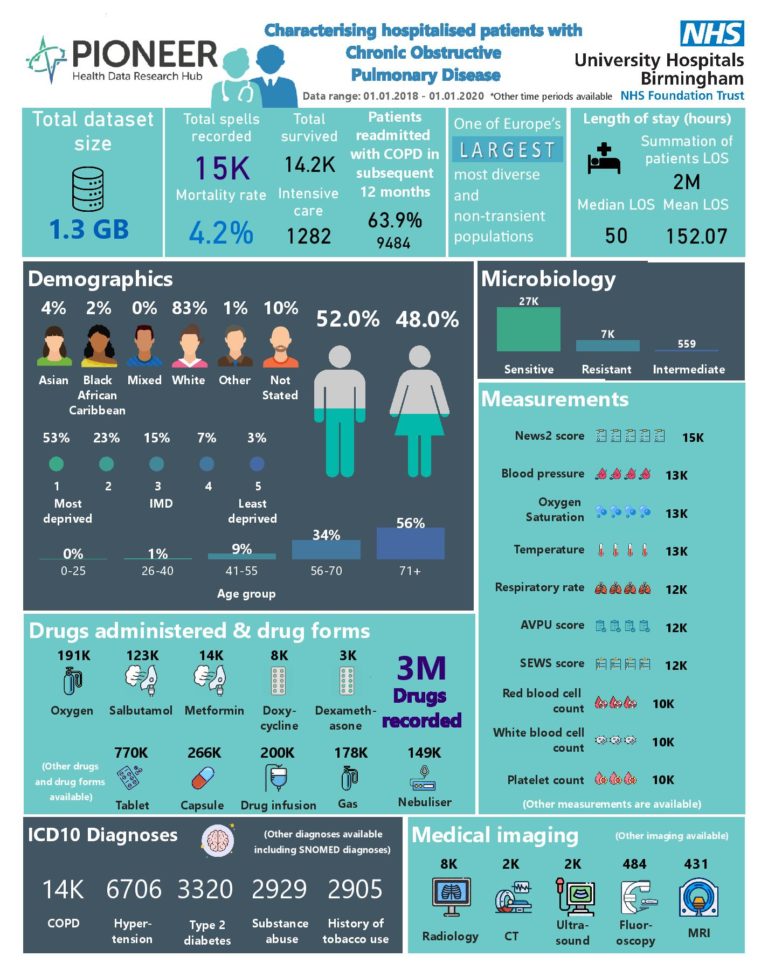
Characterisation of hospitalised COPD exacerbations using real world data
Chronic respiratory diseases remain one of the leading causes of death from non-communicable disease, with the majority of deaths due to Chronic Obstructive Pulmonary Disease (COPD). COPD presents a significant healthcare burden and is detrimental to quality of life. Currently, there are no disease modifying treatments.

The impact of COVID on hospitalised patients with COPD and hospital services
This dataset explores the impact of hospitalisation and service use in patients with COPD during the COVID pandemic.

Investigating the impact of frailty, age and illness severity during COVID-19
Frailty is a syndrome of increased vulnerability to incomplete resolution of homeostasis following a stressor event and it is associated with poor outcomes including increased mortality and reduced quality of life. Prevalence increases with age, but it should not be considered an inevitable consequence of ageing.
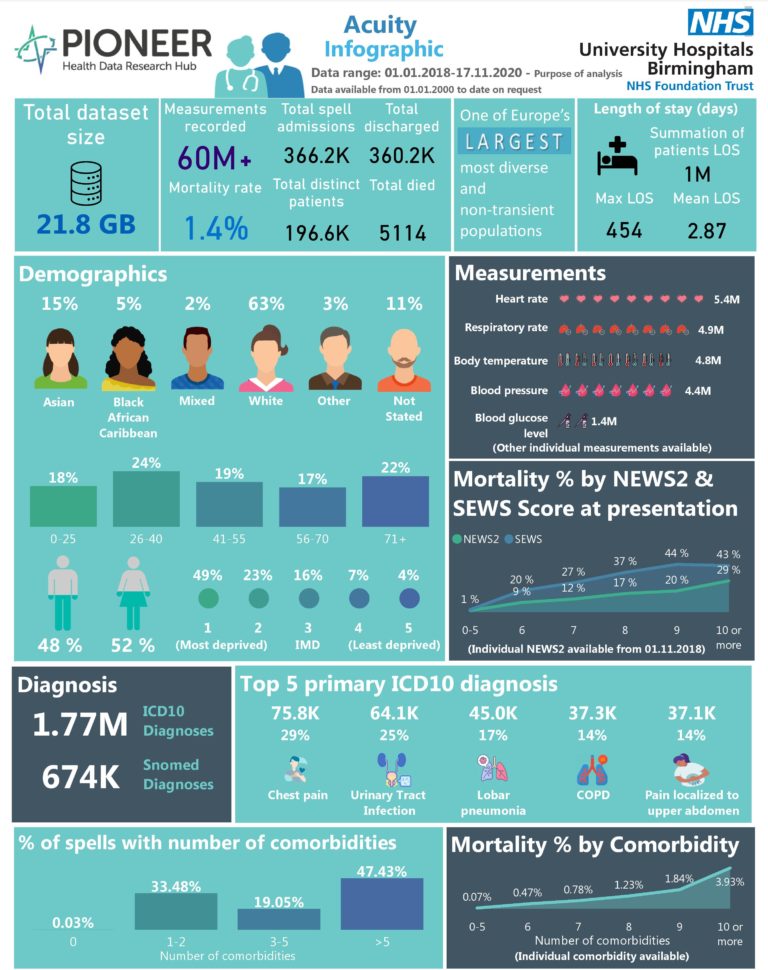
Clinical response thresholds (acuity) in acutely unwell patients: onset-outcome
Early warning systems (EWS) are bedside tools used to assess basic physiological parameters to identify patients with potential or established critical illness.

Risk and outcomes of coagulopathies in acutely unwell adults
Coagulopathies and bleeding disorders can reflect hereditary conditions such as Haemophilia or von Willebrand disease, be associated with other diseases such as liver conditions, sepsis, trauma or be iatrogenic, related to therapies or their side effects.

Ventilation strategies for patients on intensive care
Acute respiratory failure is commonly encountered in the emergency department (ED). Early treatment can have positive effects on long-term outcome.

Deeply-phenotyped hospital COVID patients: Acuity, severity, therapies, outcomes
Acuity scores are composite scores which help identify patients who are more unwell to support and prioritise clinical care.
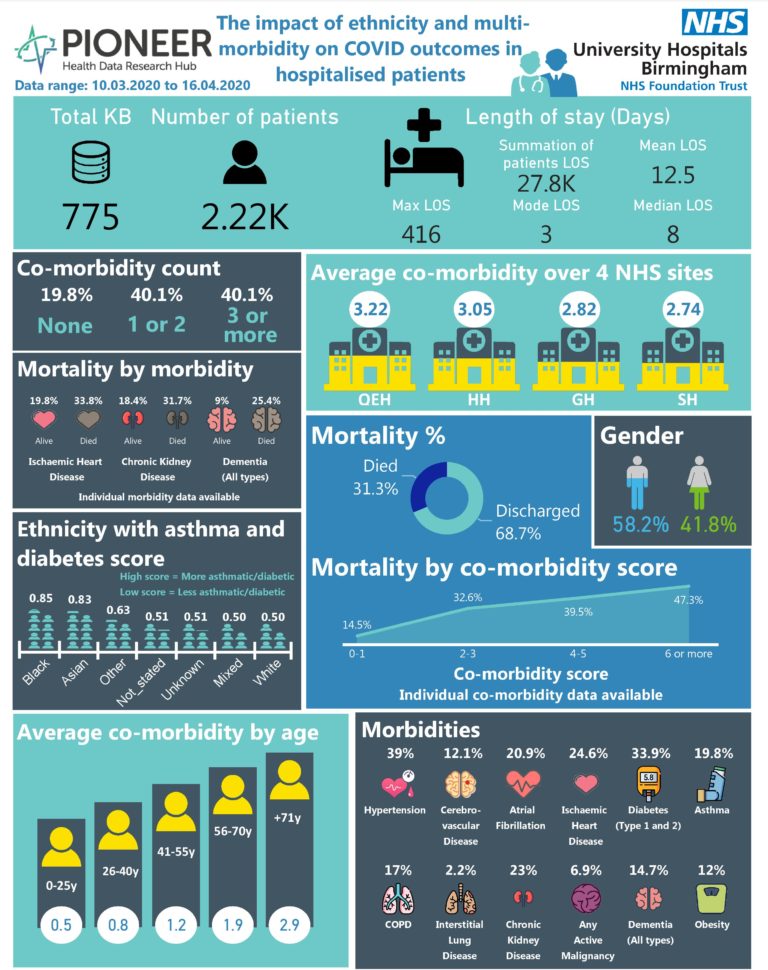
The impact of ethnicity and multi-morbidity on C19 hospitalised outcomes
Some individuals experience severe manifestations of infection, including adult respiratory distress syndrome (ARDS) and death.

The impact of hospitalised patients with COPD: from admission to outcome
Chronic obstructive pulmonary disease (COPD) is a debilitating lung condition characterised by progressive lung function limitation.

Deeply phenotyped sepsis patients within hospital: onset, treatments & outcomes
Sepsis is life-threatening organ dysfunction due to a dysregulated host response to infection and is a global health challenge.
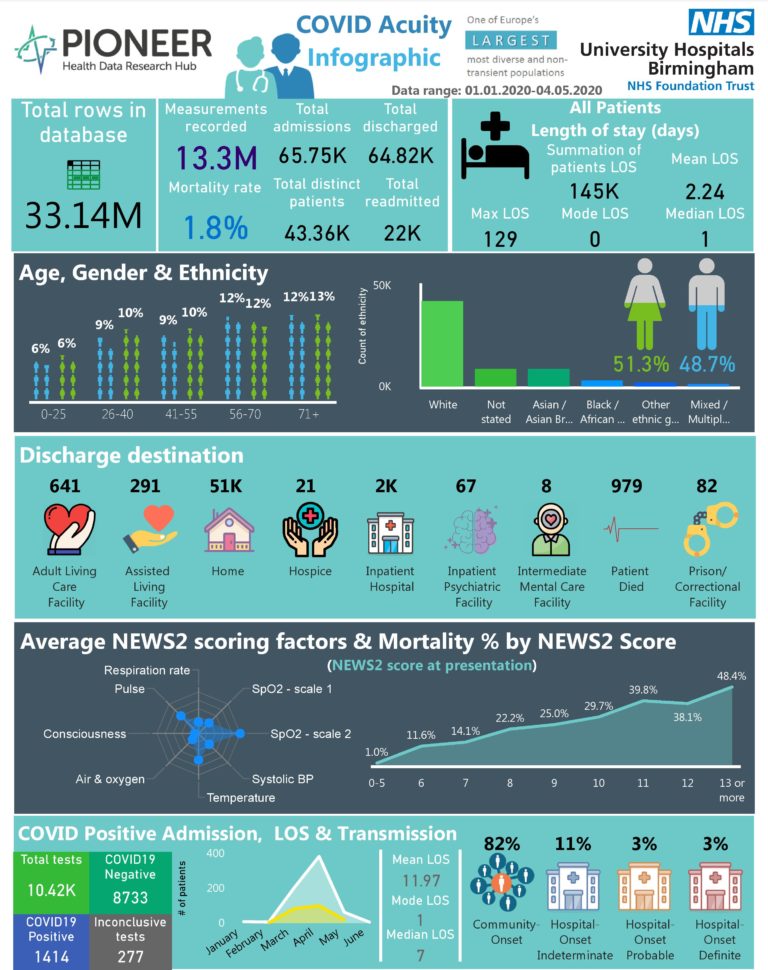
OMOP dataset: Hospital COVID patients: severity, acuity, therapies, outcomes
Coronavirus disease 2019 (COVID-19) was identified in January 2020. Currently, there have been more than 6 million cases& more than 1.5 million deaths worldwide.

2019 Summer Society of Acute Medicine Benchmarking Audit Hospital care pathways
The Society for Acute Medicine (SAM) Benchmark Audit (SAMBA) is a national benchmark audit of acute medical care.

Winter 2020 Society of Acute Medicine Benchmarking Audit Hospital care pathways
The Society for Acute Medicine (SAM) Benchmark Audit (SAMBA) is a national benchmark audit of acute medical care.

The impact of COVID on hospitalised patients with COPD: a dataset in OMOP
Chronic obstructive pulmonary disease (COPD) is a debilitating lung condition characterised by progressive lung function limitation.

Coagulopathies & arterial/venous thrombosis in COVID patients: an OMOP dataset
In December 2019, the first case of severe acute respiratory syndrome coronavirus 2 (SARS-COV-2) was described and by March 2020, the World Health Organization had declared the disease a pandemic.

Ventilatory strategies and outcomes for patients with COVID: a dataset in OMOP
Coronavirus disease 2019 (COVID-19) was identified in January 2020. Currently, there have been more than 6 million cases & more than 1.5 million deaths worldwide.






